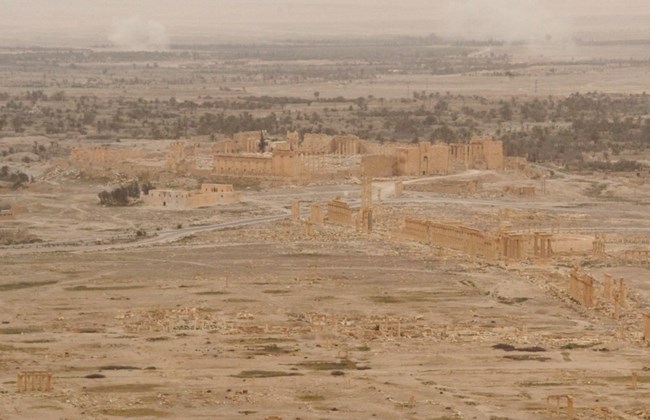
A general view taken on March 26, 2016, shows the ancient oasis city of Palmyra, northeast of the capital Damascus, during a military operation by Syrian pro-government forces to retake the ancient city from ISIS.
DAMASCUS – Once Syria recaptures the city, Palmyra’s ancient Roman temples and archway, blown up by ISIS militants last year, will be restored from the ultra-hardline group, said the head of the antiquities authority on Saturday.
Mamoun Abdelkarim revealed his hopes regarding Palmyra, saying it would be retaken within few days, after pro-government forces got their way into the western and northern parts of the city, and the latter promised to revive the Roman-era monuments “as a message against terrorism”.
Noting that the temples of Baal Shamin and Bel, were dynamited by ISIS militants, in addition to the funeral towers and a triumphal arch, which had stood for 1,800 years in the oasis city described by the U.N. cultural agency as a crossroads of cultures since the dawn of humanity.
The documented and broadcast violent group’s acts of cultural destruction in Syria and neighboring Iraq, shows the same thoroughness as its shooting, beheading, drowning and burning of prisoners, which were condemned by the U.N. as war crimes.
However, despite all the damage, Abdelkarim said film footage he had seen from Palmyra in recent days, including some taken by a drone flying over the old city, had been reassuring.
He added that there are many structures that were still standing, including the walls around the Temple of Bel, the amphitheatre, the long colonnaded avenue and Palmyra’s striking tetrapylon – a platform with four columns at each corner. But according to Abdelkarim, it would be impossible to measure the real scale of the damage until a team was able to enter the city, which has been under ISIS control since May last year.
“We still fear what happened there … the destruction of the two temples, the triumphal arch and the funeral towers,” he said. Another unanswerable question so far was the scale of secret excavations which may have taken place.
ISIS’s opponents have said that, as well as its highly publicized destruction of cultural sites, the group has also been heavily involved in antiquities smuggling to raise money.
Syria has the ability to get back any robbed artifact if they came onto the market for sale because they could easily be identified. He also promised to restore as much as possible of the damaged sites, said Abdedlkarim.
“We will rebuild them with the stones that remain, and with the remaining columns,” he said. “(We will) bring life back to Palmyra”.
